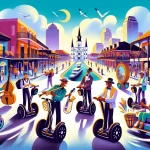Embark on an enchanting journey through the captivating wilderness of Dr. Wagner’s Honey Island Swamp Tours, a treasured attraction tucked away in New Orleans. Spanning over 70,000 acres of permanently protected wildlife area, Honey Island Swamp stands as one of the nation’s least-altered river swamps, offering a pristine and unforgettable experience. This article delves into the allure of these tours, unveiling the rich biodiversity, unique cultural experiences, and the essence that makes them a must-visit for locals and travelers alike.
In This Article
TL;DR
- Dr. Wagner’s Honey Island Swamp Tours provide an unparalleled opportunity to explore a remarkably preserved wetland ecosystem in Louisiana.
- The tours offer an immersive experience, showcasing the diverse flora and fauna while also celebrating the region’s cultural heritage.
- Thoughtful planning, including considering the best times to visit, what to bring, and how to make the most of your swamp tour adventure, can enhance your overall experience.
The Essence of Dr. Wagner’s Honey Island Swamp Tours
The History and Legacy of Dr. Wagner
Dr. Wagner’s Honey Island Swamp Tours was founded in 1982 by a professional wetland ecologist who wanted to share the beauty and importance of Louisiana’s swamps with the world. Dr. Wagner’s contributions to conservation and education about the swamp have been instrumental in preserving this unique ecosystem for future generations. The tours have provided a way for people from all over the world to explore and appreciate the swamp while learning about its history, ecology, and inhabitants.
What Makes These Tours Unique
What sets Dr. Wagner’s tours apart from other swamp tours in New Orleans is the personalized, interpretative experience provided by knowledgeable guides. The tours take place on small, intimate boats that allow for a closer look at the swamp’s flora and fauna. The routes taken wind through the interior of the swamp, offering views of cypress trees draped in Spanish moss, wild azaleas, and the chance to spot wildlife such as alligators, deer, raccoons, wild boar, and exotic birds.
Planning Your Adventure
Best Times to Visit
The best time to visit Honey Island Swamp is during the spring and fall months when the weather is mild and the vegetation is lush. Spring brings blooming wildflowers and nesting birds, while fall offers cooler temperatures and the chance to see migratory species. Summer can be hot and humid, but it’s also a great time to see alligators basking in the sun.
What to Expect
During the two-hour narrated boat tour, visitors can expect to learn about the history and ecology of the swamp from their expert guide. Potential wildlife sightings include alligators, turtles, herons, egrets, and even bald eagles. The tour also includes unique experiences like the guide making certain sounds to attract gators and rewarding them with marshmallows.
Preparing for the Tour
To make the most of your swamp tour, wear comfortable, weather-appropriate clothing and shoes that you don’t mind getting a bit muddy. Bring sunscreen, insect repellent, a hat, and sunglasses, as well as a camera to capture the stunning scenery and wildlife. Binoculars can also enhance your viewing experience.
Immersive Cultural Experiences
The Swamp as a Cultural Icon
Honey Island Swamp has long been a source of inspiration for local culture, folklore, and art in New Orleans. Tales of pirates and even sightings of the legendary “Honey Island Swamp Monster” have added to the mystique of the swamp. The tours offer a chance to immerse yourself in these stories and traditions.
Connecting with Local Traditions
During the tour, guides may share local legends, folklore, and even a bit of music to give visitors a taste of the rich cultural heritage tied to the swamp. Learning about the ways in which the swamp has shaped the lives and traditions of those who have called this area home for generations provides a deeper appreciation for this unique environment.
Seasonal Festivals and Events
Swamp-Related Festivals
New Orleans hosts several festivals throughout the year that celebrate the city’s connection to its natural surroundings, including the swamps. The Louisiana Swamp Festival, held annually in nearby Audubon, features live music, food, crafts, and exhibits highlighting the importance of the state’s wetlands.
How the Tours Adapt
Dr. Wagner’s Honey Island Swamp Tours may offer special experiences or themed tours in alignment with local festivals or seasonal events. For example, during Mardi Gras, the tours may incorporate elements of the celebration or share stories of how the swamp has played a role in the city’s famous carnival traditions.
The Wildlife of Honey Island Swamp
A Biodiversity Hotspot
Honey Island Swamp is home to an incredible variety of plant and animal life, making it a true biodiversity hotspot. Visitors on the tours can expect to see a range of species, from the iconic American alligator to more elusive creatures like the red wolf and Florida cougar. The swamp’s birdlife is also impressive, with the chance to spot herons, egrets, ibises, and even the majestic bald eagle, which has had an active nest in the swamp since 1910.
Conservation Efforts
Dr. Wagner’s Honey Island Swamp Tours play an important role in promoting conservation and educating visitors about the importance of preserving the swamp’s natural beauty. By showcasing the incredible biodiversity and unique ecosystem of the swamp, the tours inspire a greater appreciation and understanding of the need to protect these wetlands. Visitors can contribute to conservation efforts by supporting eco-friendly tourism practices and spreading awareness about the importance of Louisiana’s swamps.
Beyond the Swamp: Related Activities in New Orleans
Other Nature-Based Experiences
New Orleans offers a variety of other nature-based attractions and tours that complement the experience at Honey Island Swamp. The Barataria Preserve, part of the Jean Lafitte National Historical Park and Preserve, features boardwalk trails through a cypress swamp and the chance to see alligators, birds, and other wildlife. The Audubon Zoo and Audubon Aquarium of the Americas also provide opportunities to learn about the region’s diverse flora and fauna.
Cultural Extensions
To extend your cultural experience in New Orleans, consider visiting the New Orleans Historic Voodoo Museum to learn more about the city’s fascinating history with this spiritual practice, which has ties to the swamps and bayous of Louisiana. The New Orleans Jazz Museum and the New Orleans Museum of Art also offer insights into the city’s rich cultural heritage and the ways in which the natural environment has influenced local art and music.
Deepening the Experience
Engaging with Experts
One of the highlights of Dr. Wagner’s Honey Island Swamp Tours is the opportunity to engage with expert guides who are passionate about sharing their knowledge of the swamp’s ecology and history. Many of the guides have backgrounds in biology, ecology, or environmental science, bringing a wealth of expertise to enhance the visitor experience.
Educational Opportunities
In addition to the informative narration provided during the tour, Dr. Wagner’s Honey Island Swamp Tours also offers educational materials and programs that deepen visitors’ understanding of the swamp’s ecosystem and cultural significance. These resources may include brochures, species identification guides, or even special tours designed for school groups or those with a keen interest in learning more about the swamp.
Address: 41490 Crawford Landing Rd, Slidell, LA 70461
Phone: (985) 641-1769 or (504) 242-5877
Hours: Tours available by reservation, call between 8 am – 8 pm
Prices: Rates vary, contact for current pricing
By embarking on a journey with Dr. Wagner’s Honey Island Swamp Tours, visitors will gain a deep appreciation for the natural wonders and cultural richness of New Orleans’ swamps. This immersive experience offers a chance to disconnect from the hustle and bustle of the city and reconnect with the beauty and serenity of the natural world. With expert guides, unique wildlife encounters, and a focus on conservation and education, these tours provide an unforgettable adventure that showcases the very best of Louisiana’s wild side.






